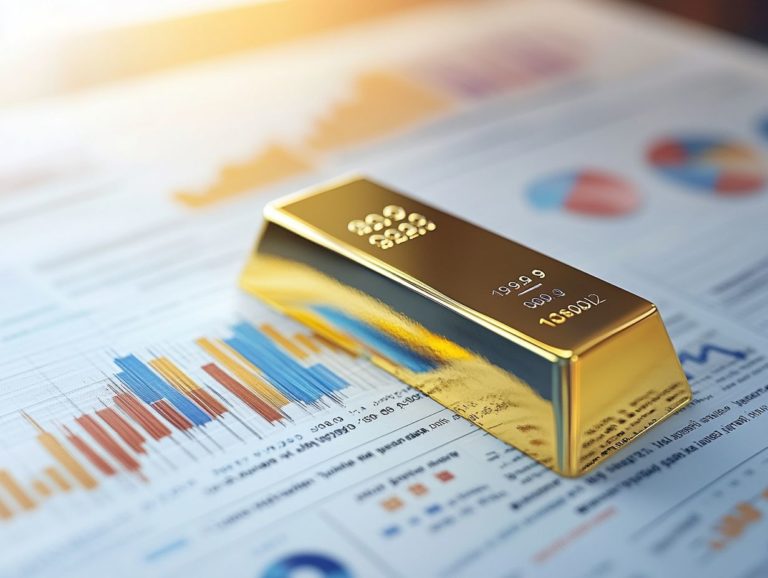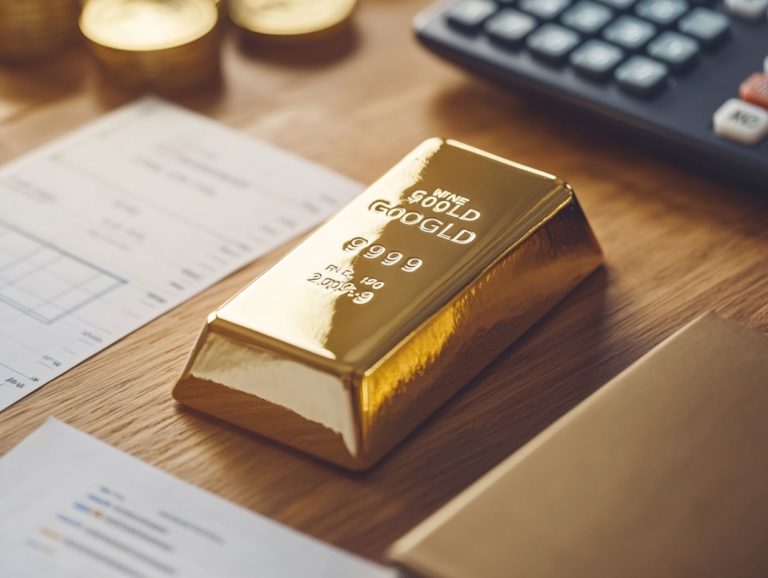How to Use Gold as an Investment Diversifier
In today s unpredictable financial landscape, diversification has become an essential strategy for you as an investor seeking to safeguard your portfolio.
Among the myriad of options available, gold emerges as a time-tested asset, offering distinct advantages that can t be overlooked. This article delves into the significance of diversification, underscoring the benefits of incorporating gold to manage inflation, mitigate risk, and provide stability amid market fluctuations.
Are you ready to discover how gold can elevate your investment strategy? Dive in to uncover practical avenues for investing in gold, from physical assets to ETFs and mining stocks, while considering key factors to evaluate before making any commitments.
Contents
- Key Takeaways:
- What is Diversification and Why is it Important?
- Benefits of Using Gold as a Diversifier
- Ways to Invest in Gold
- Factors to Consider Before Investing in Gold
- Frequently Asked Questions
- What is gold and why is it considered a valuable investment?
- How can I use gold as an investment diversifier?
- What are the different ways to invest in gold?
- Is gold a safe investment option?
- What are the benefits of using gold as an investment diversifier?
- Are there any downsides to using gold as an investment diversifier?
Key Takeaways:
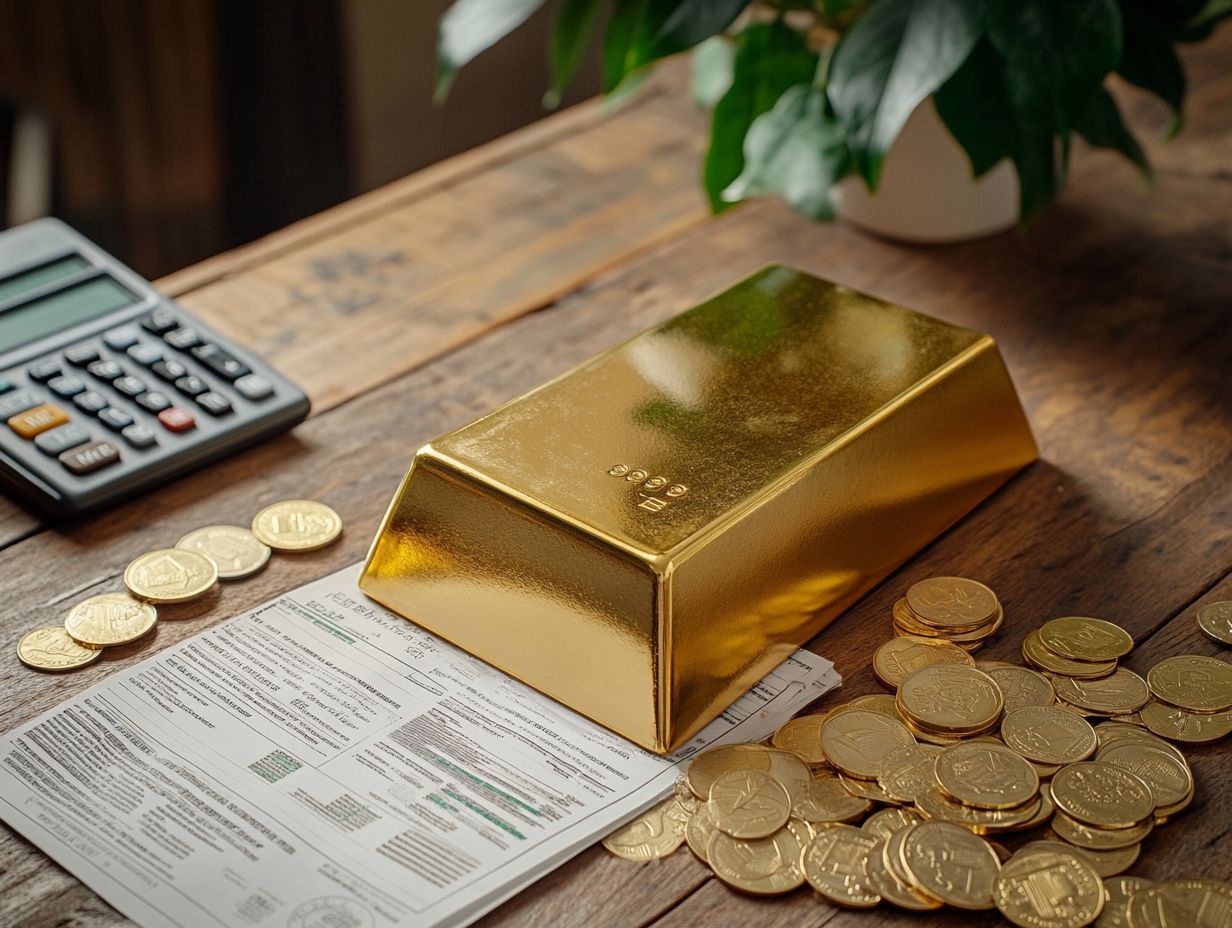
Diversification is crucial for a well-rounded investment portfolio. Gold can protect you against inflation and provide stability during market upheaval!
Invest in physical gold, gold ETFs, or gold mining stocks. However, consider market conditions, costs, and storage options before making a decision.
What is Diversification and Why is it Important?
Diversification is an essential investment strategy that allows you to spread your investments across various asset classes. This helps to minimize risk while enhancing potential returns.
In the unpredictable realm of financial markets shaped by shifting economic conditions, inflation, and market fluctuations a well-diversified portfolio can play a crucial role in securing long-term gains. You ll want to lower your risk exposure by including a mix of securities in your portfolio.
Consider stocks, bonds, and precious metals. This strategy not only aims to optimize your financial performance but also helps ensure stability during turbulent times.
Benefits of Using Gold as a Diversifier
Incorporating gold into your investment portfolio can provide a wealth of advantages, especially as a way to maintain financial stability amid turbulent economic times.
Throughout history, gold has proven to be a dependable asset that retains its value. It is appealing for those seeking to mitigate risk in their investments.
The World Gold Council highlights that including gold can enhance the risk-return profile of your overall investment strategy. This ensures a well-rounded approach to safeguarding your financial future.
Inflation Hedge
Gold has long been a robust hedge against inflation. It retains its value, even when inflation rates rise and the value of your money diminishes. During economic turbulence, gold prices tend to hold steady or even appreciate, offering you a safeguard.
Historically, during significant inflationary periods like those dramatic late 1970s gold experienced a remarkable surge. It skyrocketed from around $35 per ounce to over $800 by 1980, translating to an astounding 23-fold increase.
This trend illustrates that amidst economic uncertainty, characterized by rising consumer prices and weakened fiat currencies, many still turn to gold as a reliable store of value. Current analyses indicate that as inflation expectations rise, gold retains its allure. It frequently outperforms equities and bonds in terms of real returns.
This makes it a strategic asset for your diversified investment portfolio, designed to help you navigate the financial storms ahead.
Portfolio Risk Management
Effective portfolio risk management requires you to strategically allocate investments across various asset classes, including gold, to mitigate potential losses and enhance your financial stability. By adding gold to your portfolio, you can reduce exposure to market volatility and economic turbulence, ensuring a balanced approach that protects against negative returns during downturns.
This strategic diversification not only serves as a hedge against inflation but also complements other assets like equities and bonds. In volatile market conditions, gold shines, acting as a safe haven that retains value when other investments may stumble. To further secure your holdings, it’s important to learn how to protect your gold investments.
Consider your investment strategies carefully to bolster your resilience by mixing in alternative investments alongside precious metals. Staying attuned to market trends and adjusting your holdings as necessary enables you to respond to shifting economic landscapes, creating a more robust investment framework.
Stability in Market Fluctuations
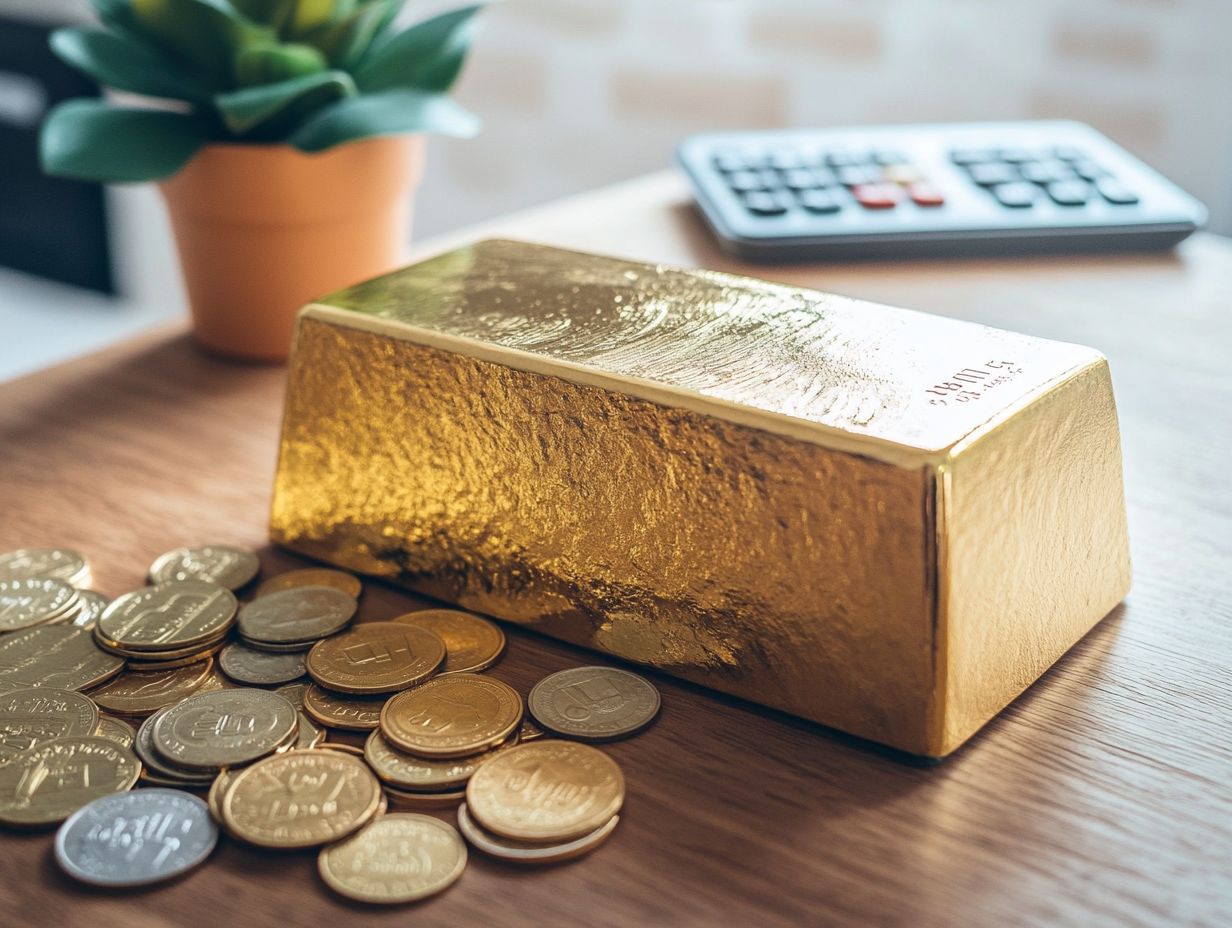
Gold stands out for its remarkable stability amidst market fluctuations, making it an essential asset as you navigate uncertain economic conditions and stock market volatility. Unlike other investment classes, gold often behaves as a safe haven during tumultuous times, providing a reliable source of value that can help offset declines in stock prices.
This intrinsic value is vital when economic indicators hint at potential downturns or when geopolitical tensions escalate, stirring unease among investors. By adding gold to your portfolio, you enhance diversification, reducing your overall risk exposure while also positioning yourself to benefit from potential appreciation. To understand when to buy gold, it’s essential to monitor these factors as demand for this precious metal rises.
As a hedge against inflation and currency depreciation, gold preserves purchasing power while offering a reassuring sense of security. This enables you to better withstand the unpredictable dynamics that define today s financial landscape.
Ways to Invest in Gold
Investing in gold opens up a world of possibilities, each with its own set of benefits and risks. Choose wisely to maximize your investment potential!
You might consider physical gold such as bullion or coins or perhaps you prefer abstract forms like gold ETFs (investment funds that hold gold) and mining stocks. The rising interest in precious metals underscores their value as compelling investment opportunities.
These various options enable you to diversify your portfolio effectively while capitalizing on the potential for long-term gains.
Physical Gold
Investing in physical gold, whether bullion or coins, is a compelling choice for anyone seeking to incorporate tangible assets into their portfolio. Holding physical gold gives you direct exposure to precious metals, which can offer potential for long-term gains and serve as a hedge against inflation and economic uncertainty.
One of the most attractive features of owning physical gold is its intrinsic value, universally acknowledged across various cultures and economic systems. Unlike stocks and bonds, physical gold doesn’t depend on a counterparty, providing security even amid market turbulence.
However, you must weigh the practical challenges associated with physical ownership, such as storage, insurance, and potential liquidity issues.
While adding gold coins or bars can enhance the diversity of your portfolio, be mindful that fluctuations in the gold market can lead to significant price swings. This necessitates careful timing and a well-thought-out strategy, such as understanding how to invest in gold, to navigate the investment landscape effectively.
Gold ETFs
Gold ETFs offer a seamless way to invest in gold without the hassle of physically holding the metal. This makes trading and market access a breeze. These exchange-traded funds track the price of gold and serve as a convenient and liquid investment option for anyone looking to diversify their portfolio with precious metals.
The appeal of gold ETFs lies in their high liquidity, allowing for quick buying or selling on the stock exchange a significant advantage for active traders. You’ll appreciate the simplicity of purchasing shares through your brokerage account, eliminating the complexities that come with traditional gold investments, such as storage and security concerns.
While these funds generally come with minimal management costs, they may also carry annual fees and can be subject to market volatility. Therefore, understanding both the advantages and disadvantages is essential as you consider integrating gold ETFs into your investment strategy.
Gold Mining Stocks
Investing in gold mining stocks provides an indirect way to engage with gold prices, as the performance of these equities often aligns closely with gold prices. By choosing to invest in mining companies, you can capitalize on market rallies and benefit from the operational efficiencies these firms leverage in response to fluctuating gold prices.
This distinctive investment approach allows you to establish a presence in the precious metals market without purchasing physical gold. However, be aware that investing in these stocks comes with risks, including operational challenges, regulatory hurdles, and geopolitical factors that may affect production. To further enhance your investment strategy, consider how to use gold to diversify your portfolio.
The variability in gold prices can lead to inconsistent returns, highlighting the importance of conducting thorough research and considering diversification strategies to mitigate potential losses. By understanding these dynamics, you can navigate the complexities of the gold mining sector more effectively and learn how to sell your gold investments profitably to align your investment goals with market performance.
Factors to Consider Before Investing in Gold

Before investing in gold, consider these crucial factors to make well-informed decisions that align seamlessly with your overall investment strategy. Market conditions, including economic indicators and inflation rates, significantly influence the timing and approach of your gold investment.
It’s also important to understand costs, fees, and the logistics of storage and security when incorporating gold into your portfolio. Taking these elements into account will enable you to navigate this precious metal investment with confidence and clarity.
Market Conditions
Market conditions play a pivotal role in the viability of your gold investments, with factors such as inflation, interest rates, and economic stability directly influencing gold prices. Stay alert! Economic indicators can change quickly, affecting your investments.
Understanding these correlations becomes even more crucial during economic turbulence, when gold is often regarded as a safe haven. For instance, when inflation rates soar, the purchasing power of your currency may dwindle, typically driving you and other investors toward gold as a protective measure. If you’re considering investing in gold, you might want to explore the best places to buy physical gold. Conversely, high interest rates can diminish the allure of non-yielding assets like gold, pushing you to favor interest-bearing investments instead.
By carefully monitoring these dynamic conditions, you can adeptly navigate the complexities of gold investments and elevate your overall financial strategy.
Costs and Fees
When you consider gold investments, it s crucial to evaluate the associated costs and fees that could impact your overall returns. This includes transaction costs and management fees.
Understanding these financial aspects is vital to ensuring that your investment strategy remains profitable and aligned with your financial goals.
Beyond the initial purchase price, be aware of various transaction fees that can arise when buying physical gold. These fees include shipping, insurance, and storage costs, all of which add to your overall investment expense.
If you re considering gold exchange-traded funds (ETFs), remember to include the fees for managing your investments, which can differ based on the type of fund. Understanding taxes on capital gains is crucial because it can significantly affect your net returns.
By taking a closer look at these costs, you can make smarter investment choices that align with your financial goals. Taking an informed approach will help clarify these costs and enhance your investment experience.
Storage and Security
Storage and security should be at the forefront of your mind when dealing with physical gold. It’s essential to safeguard your investments from theft and damage.
Consider options like secure vaults, insurance, and safety deposit boxes to ensure these valuable assets remain protected.
Many investors opt for private storage facilities that specialize in precious metals. These facilities offer added layers of protection and expertise, ensuring your investments are in capable hands.
Investing in insurance coverage can also bring you peace of mind, helping to mitigate potential losses from unexpected events like natural disasters or unforeseen thefts.
Take the time to thoroughly evaluate your options and select a storage solution that aligns with your risk tolerance and investment strategy. Implementing robust protective measures not only preserves the integrity of your physical gold investments but also enhances your overall financial security.
Frequently Asked Questions
What is gold and why is it considered a valuable investment?
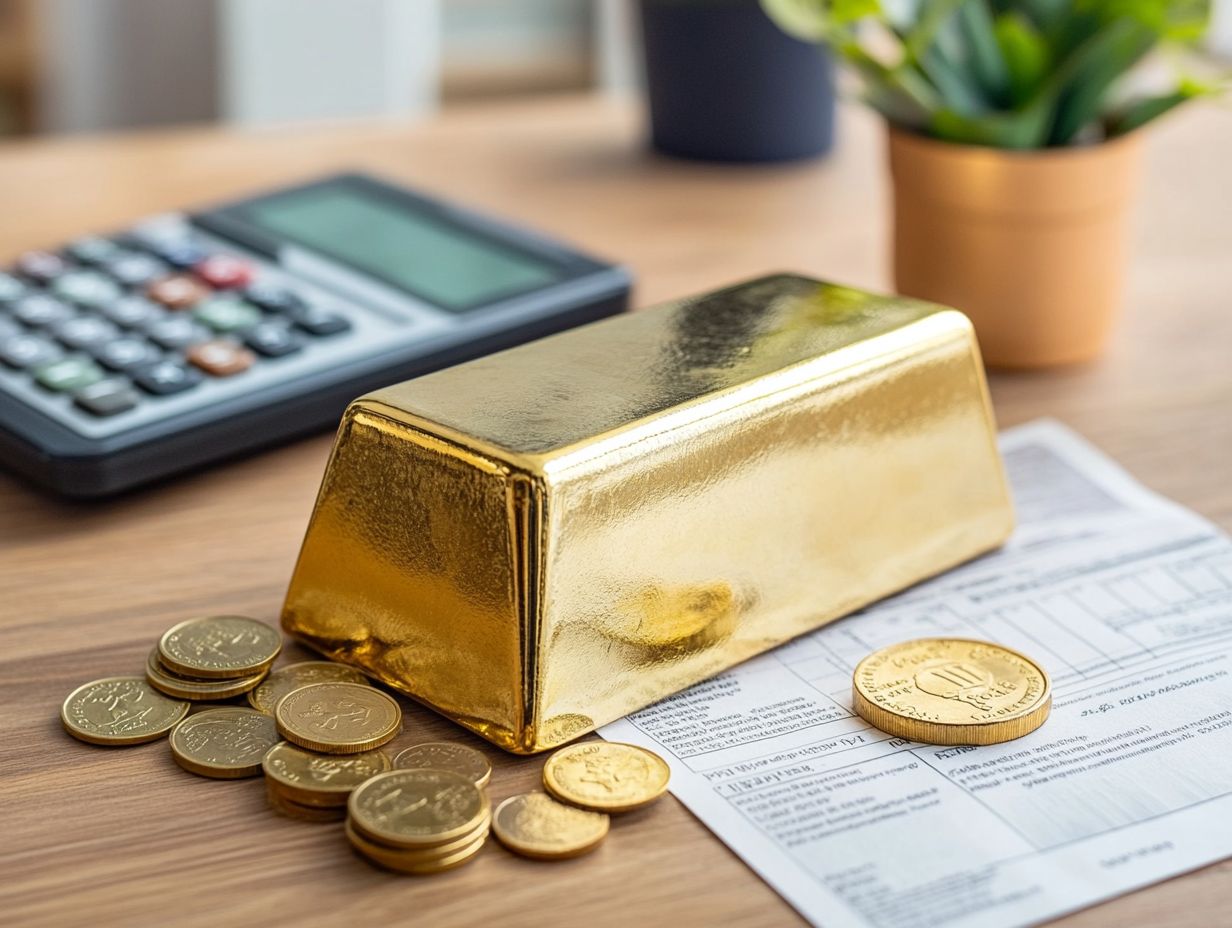
Gold is a precious metal that has been used as a form of currency and a store of value for thousands of years. Its scarcity and durability make it valuable, especially during times of economic uncertainty.
How can I use gold as an investment diversifier?
You can use gold to diversify your investment portfolio, which means spreading your investments across different types of assets. By including gold in your portfolio, you can potentially reduce risk and protect against market fluctuations.
What are the different ways to invest in gold?
You can invest in gold in several ways, including buying physical gold in the form of coins or bars, investing in gold exchange-traded funds (ETFs), or purchasing shares of gold mining companies.
Is gold a safe investment option?
Gold is generally considered a safe investment option, as it tends to hold its value over time and can act as a hedge against inflation. However, like any investment, there is always a level of risk involved, and its value can fluctuate.
What are the benefits of using gold as an investment diversifier?
In addition to potentially reducing risk and protecting against market fluctuations, gold can also offer liquidity, as it is a highly liquid asset that can easily be bought and sold. It can also provide portfolio balance and stability, as it often has a low correlation to other assets.
Are there any downsides to using gold as an investment diversifier?
One downside of investing in gold is the potential for storage and insurance costs, especially if you choose to invest in physical gold. There is also the risk of market fluctuations and the possibility of not earning as high a return compared to other investments in the long term.











